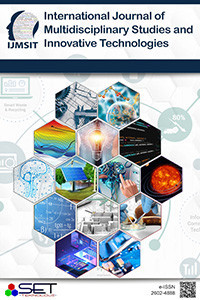MARC: Mining Association Rules from datasets by using Clustering models
MARC: Mining Association Rules from datasets by using Clustering models
Association Rules, Unsupervised Learning, Multi-SOM Model, Symbolic Model Clustering Model, Numerical Dataset,
___
- U. M. Fayyad, G. Piatetsky-Shapiro, P. Smyth, and R. Uthurusamy, “Advances in knowledge discovery and data mining,” 1996.
- D. T. Larose and D. T. Larose, Data mining methods and models, vol. 2. Wiley Online Library, 2006.
- S. Al Shehabi and J.-C. Lamirel, “Knowledge extraction from unsupervised multi-topographic neural network models,” in International Conference on Artificial Neural Networks, 2005, pp. 479–484.
- K.-C. Lin, I.-E. Liao, and Z.-S. Chen, “An improved frequent patterngrowth method formining association rules,” Expert Syst. Appl., vol. 38, no. 5, pp. 5154–5161, 2011.
- B. Liu, W. Hsu, and Y. Ma, “Miningassociation rules with multipleminimum supports,” in Proceedings of the fifth ACM SIGKDD international conference on Knowledge discovery and data mining, 1999, pp. 337–341.
- Y.-H. Hu and Y.-L. Chen, “Miningassociation rules with multiple minimum supports: anew mining algorithm and a support tuning mechanism,” Decis. Support Syst., vol. 42, no. 1, pp. 1–24, 2006.
- C.-W. Lin, T.-P. Hong, and W.-H. Lu, “An effective tree structure for mining high utility itemsets,” Expert Syst. Appl., vol. 38, no. 6, pp. 7419–7424, 2011.
- C. K.-S. Leung, L. V. S. Lakshmanan, and R. T. Ng, “Exploiting succinct constraints using FP-trees,” ACM SIGKDD Explor. Newsl., vol. 4, no. 1, pp. 40–49, 2002.
- W.-Y. Lin, K.-W. Huang, and C.-A. Wu, “MCFPTree: An FP-tree-based algorithm for multi-constraint patterns discovery,” Int. J. Bus. Intell. Data Min., vol. 5, no. 3, pp. 231–246, 2010.
- J.-L. Koh and S.-F. Shieh, “An efficient approach for maintaining association rules based on adjusting FP-tree structures,” in International Conference on Database Systems for Advanced Applications, 2004, pp. 417–424.
- S. K. Tanbeer, C. F. Ahmed, B.-S. Jeong, and Y.-K. Lee, “Efficient single-pass frequent pattern mining using a prefix-tree,” Inf. Sci. (Ny)., vol. 179, no. 5, pp. 559–583, 2009.
- Y. Lan, D. Janssens, G. Chen, and G. Wets, “Improving associative classification by incorporating novel interestingness measures,” Expert Syst. Appl., vol. 31, no. 1, pp. 184–192, 2006.
- R. Malhas and Z. Al Aghbari, “Interestingness filtering engine: Mining Bayesian networks for interesting patterns,” Expert Syst. Appl., vol. 36, no. 3, pp. 5137–5145, 2009.
- B. Vo and B. Le, “Interestingness measures for association rules: Combination between lattice and hash tables,” Expert Syst. Appl., vol. 38, no. 9, pp. 11630–11640, 2011.
- I. N. M. Shaharanee, F. Hadzic, and T. S. Dillon, “Interestingness measures for association rules based on statistical validity,” Knowledge-Based Syst., vol. 24, no. 3, pp. 386–392, 2011.
- Y. Zhao, C. Zhang, and S. Zhang, “Discovering interesting association rules by clustering,” in Australasian Joint Conference on Artificial Intelligence, 2004, pp. 1055–1061.
- I. Lee, G. Cai, and K. Lee, “Mining points-of-interest association rules from geo-tagged photos,” in 2013 46th Hawaii International Conference on System Sciences, 2013, pp. 1580–1588.
- E.-H. Han, G. Karypis, V. Kumar, and B. Mobasher, “Clustering Based On Association Rule Hypergraphs.,” in DMKD, 1997, p. 0.
- M. J. Zaki, S. Parthasarathy, M. Ogihara, and W. Li, “New Algorithms for Fast Discovery of Association Rules, 3rd Intl. Conf. on Knowledge Discovery and Data Mining.” AAAI Press, 1997.
- B. Lent, A. Swami, and J. Widom, “Clustering association rules,” in Proceedings 13th International Conference on Data Engineering, 1997, pp. 220–231.
- E. V. Altay and B. Alatas, “Intelligent optimization algorithms for the problem of mining numerical association rules,” Phys. A Stat. Mech. its Appl., vol. 540, p. 123142, 2020.
- B. Imane, B. Abdelmajid, T. A. Mohammed, and T. A. Youssef, “Data mining approach based on clustering and association rules applicable to different fields,” in 2018 International Conference on Electronics, Control, Optimization and Computer Science (ICECOCS), 2018, pp. 1–5.
- X. Polanco, C. François, and J.-C. Lamirel, “Using artificial neural networks for mapping of scienceand technology: A multi-self-organizing-maps approach,” Scientometrics, vol. 51, no. 1, pp. 267–292, 2001.
- P.-N. Tan, M. Steinbach, and V. Kumar, “Introduction to data mining. ed,” Addison-Wesley Longman Publ. Co., Inc., 2005.
- R. Agrawal and R. Srikant, “Fast algorithms for mining association rules,” in Proc. 20th int. conf. very large data bases, VLDB, 1994, vol. 1215, pp. 487–499.
- J. Han, J. Pei, Y. Yin, and R. Mao, “Mining frequent patterns without candidate generation: A frequent-pattern tree approach,” Data Min. Knowl. Discov., vol. 8, no. 1, pp. 53–87, 2004.
- J.-C. Lamirel, C. Francois, S. Al Shehabi, and M. Hoffmann, “New classification quality estimators for analysis of documentary information: application to patent analysis and web mapping,” Scientometrics, vol. 60, no. 3, pp. 445–562, 2004.
- ISSN: 2602-4888
- Yayın Aralığı: Yılda 2 Sayı
- Başlangıç: 2017
- Yayıncı: SET Teknoloji
Keivan BASİRİ, Ehsan AMİRİ, Zahra GHASEMİ, Saeed AMİRİ
N. Fırat ÖZKAN, Emre AKSOY, Gökberk ŞENSOY
Principles of John von Neumann as a basis of the Electronic Calculating Machine
Behnam ALİZADEHASHRAFİ, Mohammad DARKAHİ GHAREH BAGH, Soraya ATA, İsmail Rakıp KARAŞ
Ulaştırma Sektöründe İmdat Çekici Tasarımı ve 3B Yazıcı ile Üretimi
İbrahim YAVUZ, Emrah ERÇEK, Ahmet Fatih YURAN
MARC: Mining Association Rules from datasets by using Clustering models
Shadi AL SHEHABI, Abdullatif BABA
Opportunities and Challenges to Educators When Transitioning to a TEL Environment – Case of Kuwait
Stokastik Hesaplamada Çoklayıcıların Sınırı Üzerine
Yalova İçin Binalarda Yalıtım Kalınlığının Simülasyonla Değerlendirilmesi
Hüseyin Can ÜLGÜNER, Adil DEĞİRMENCİ, Ahmet ÜSTÜNTÜRK, Alper KELEŞOĞLU, Ümit ÜNVER
